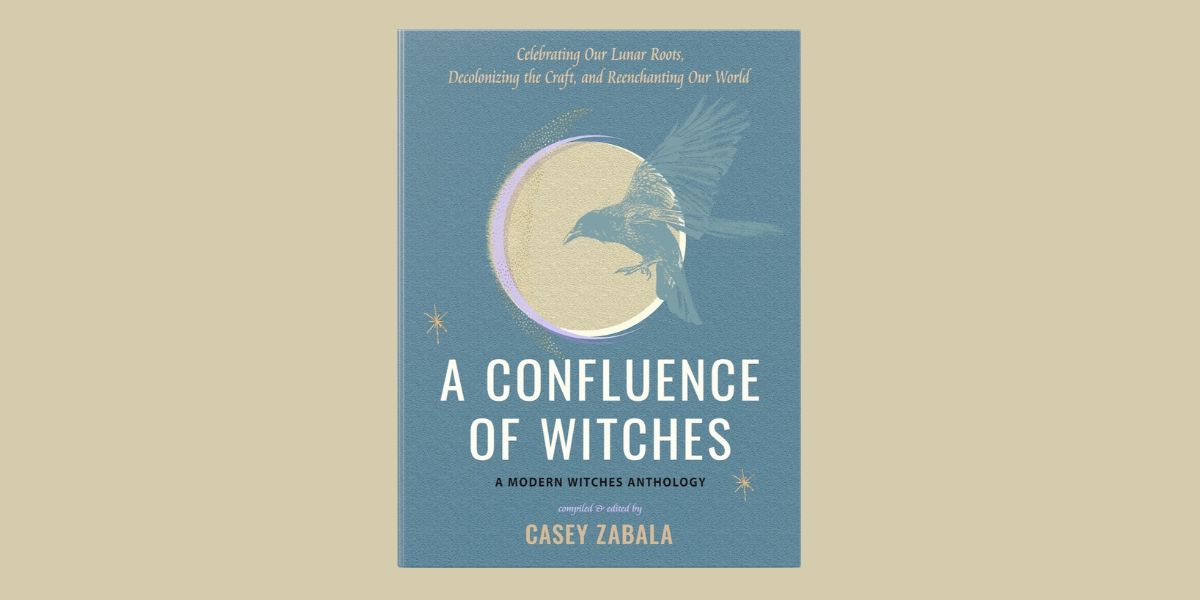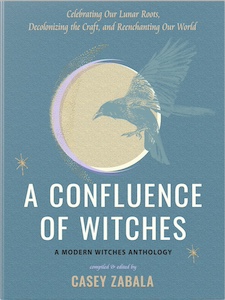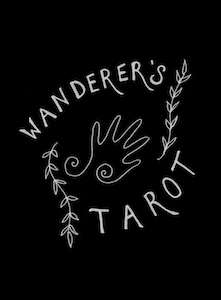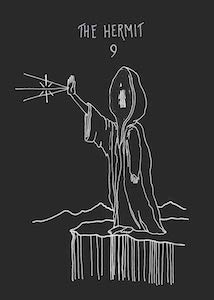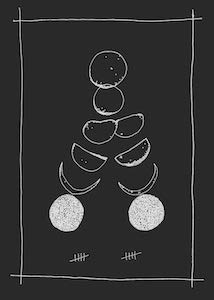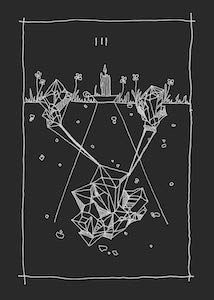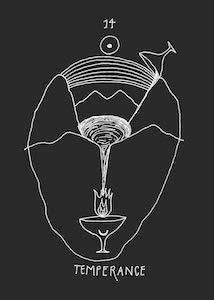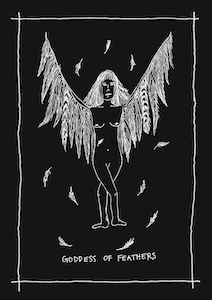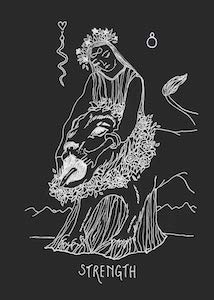
Wyrd Sisters: A Deck of Spells and Rituals, by Casey Zabala
Weiser Books, 1578638291, 60 cards, 80 pages, April 2024
Ah, destiny! For those who enjoy contemplating fate, or the inevitable outcome of events, perhaps even tempting it here and there, Wyrd Sisters: A Deck of Spells and Rituals by Casey Zabala is a true delight. The concept of “wyrd”, originating from Old English and Norse mythology related to the predetermined outcome of events, has been explored as a way to understand the interconnectedness of all things and the idea that individuals are part of a larger cosmic pattern. While wyrd implies a sense of inevitability, it also carries the idea that individuals have some agency in shaping their own destinies through their choices and actions. Calling upon the duality of fate and free will, this deck helps readers to explore the mysteries of existence and the human experience.
Zabala is a devotee of the Wyrd Sisters, describing how they “are the ancient Deities who dwelt at the roots of the world tree and set the order of the cosmos through their spinning, weaving, and cutting the cords of fate. Their threefold process affirms the cyclical nature of our being.”1 Just as they weave fate, we too are weaving our own lives:

“We weave specific patterns and shapes for protection and success, with the awareness that our spells and wishes are delivered through the web of wyrd.”2
Believing that spellwork is deeply personal, Zabala has created a very creative and open-ended deck for readers to ascribe their own meanings to the imagery and messages and then use their own magical repertoire to integrate the energy. While there is some guidance provided through the guidebook, this deck really shines as a work of art that assists readers with strengthening their own intuition, crafting their own rituals, and creating magic that feel uniquely meaningful and relevant to them.
“Magic is the fifth element–also known as spirit, ether, or quintessence. It is the ethereal nature that keeps all beings connected and psychically tethered to each other.”3
There are five types of cards in this deck: spell cards, candle magic cards, sigil cards, magical tool cards, and Wyrd Sister cards. The guidebook entry differs depending on the type of card, as the type of magic coming through is aligned to the energy of your draw.
For the spell cards, there is an intuitive message along with a list of spell ingredients that one can use for inspiration. There’s something about being given three to five things and then being told, “Now go figure out what you can do with this” that makes my creativity soar. For instance, the spell ingredients for the card Spell for Surrender are “physical inversions, amethyst, strong winds, sharing secrets with strangers, salt”6. You can absolutely use none, one, some, or all of the spell ingredients, and I feel like the process of coming up with one that feels do-able and relevant for you is magic in itself.

For the candle magic cards, Zabala offers suggestions for the color candle and what to do during your candle magic ceremony. The Candle for Vitality card reads “Call all of your energy back to yourself.. Light a yellow candle and imagine a sunlight shield protecting your auric field from outside disturbance.”7
The guidance for the sigil card includes what to use the sigil, where to place it, and the ruling planet. As an example, the Sigil for Unbinding can be used to “untangle webs of entrapment or psychic manipulation”[/efn_note]page 55[/efn_note]. Zabala notes it should be placed in a ring of salt and the ruling planet is Pluto.
With the magical tool cards, Zabala reminds us, “Each tool represents the essence of our intentions, our spiritual connections, and the art of our will.”8 The guidebook describes the tool and then offers a suggestion of how one can best use their magical energy at this time. There is suggested magic for each one, ranging from speaking one’s truth to establish a boundary (athame) to gathering with friends to celebrate transformation through “ritual, feasting, and revelry”9 (bonfire).
Last but most important are the Wyrd Sister cards. I have yet to pull one myself! I honestly didn’t even want to read the guidebook description because I feel like it’s an initiation to pull one. However, from a quick glance at Zabala’s introduction, I can see they’re related to past, present, and future.

While you can pull a card for quick insight from this deck, as you can tell from reading the various descriptions, some of the cards require some more magical effort. Whether it’s planning out your spellwork, gathering the right color candle, or making preparations to perform the suggested magic related to a tool, it can take days, perhaps even weeks, to put the energy out into the world. It seems as though only the sigil cards can be used for immediate action. But I personally enjoy how the deck calls for you to savor its message and take the time to align with one’s intention and then put forth their magical working. You can always simply see what card comes through and then reflect on it before making any energetic investments.
As for the artwork, this deck is bright, abstract, and filled with symbolism. It definitely speaks to the non-verbal part of the psyche, activating inner knowledge through images, colors, and dimension. One thing I have been doing with this deck is noticing where my eyes go first, as there’s often many places to look, for insight into what is most relevant for me. For those who enjoy divination through creative decks, you could absolutely toss the guidebook aside and find plenty of messages and meaning within the cards themselves.
My favorite card that I’ve pulled so far is Spell for Grounding. Suitably, I pulled this on a night when my lower back was completely out of whack, indicating to me that I was ungrounded and needed to focus on my root chakra, as I rested with a heating pad. The image on the card was so fascinating to look at, and I spent a good five minutes letting my eyes explore. It shows a person with their arms in the air and an infinity symbol witch hat on their head, but the torso of their body is a tree trunk. It is growing from a patch of grass, and one can see the roots below the ground, pushing downward into spirals of energy below.

The guidebook calls for connecting with the earth, listening to plants, being barefoot, and speaking the name of the native land I live on, giving thanks. All of which my body and soul gave a resounding “yes, yes, yes, yes” as I read the entry and continued to meditate on the card. In this case, I didn’t feel a whole spell was needed; simply going outside and laying on the ground seemed to be enough, which I guess could be considered a simple spell in itself, but as Zabala intended, to each their own with this deck!
All in all, Zabala has created a really cool deck for those who love to explore their own magic and discover new possibilities. Wyrd Sisters is the perfect blend of intuitive guidance and freedom to roam with one’s own interpretation. Within the liminal magical space, we have the opportunity to discover our destiny, while also actively changing our fate. It all comes down to the willingness to ride the waves of mystery and magic, learning when to surrender and when to pursue. The Wyrd Sisters may be the universal weavers, but we are the active co-creators shaping the web too. As Zabala encourages:
“May your connection with the Wyrd ones inspire you to embrace the mystery and weave your own magical webs of belonging.”10
Alanna Kali is an astrologer, numerologist, and pioneer spirit that loves to explore life through the lens of depth psychology. She has a passion for studying the humanities and social trends. Her academic work is centered upon reuniting body, mind, and spirit through eco-psychology. She loves reading, spending time in nature, and travel.

